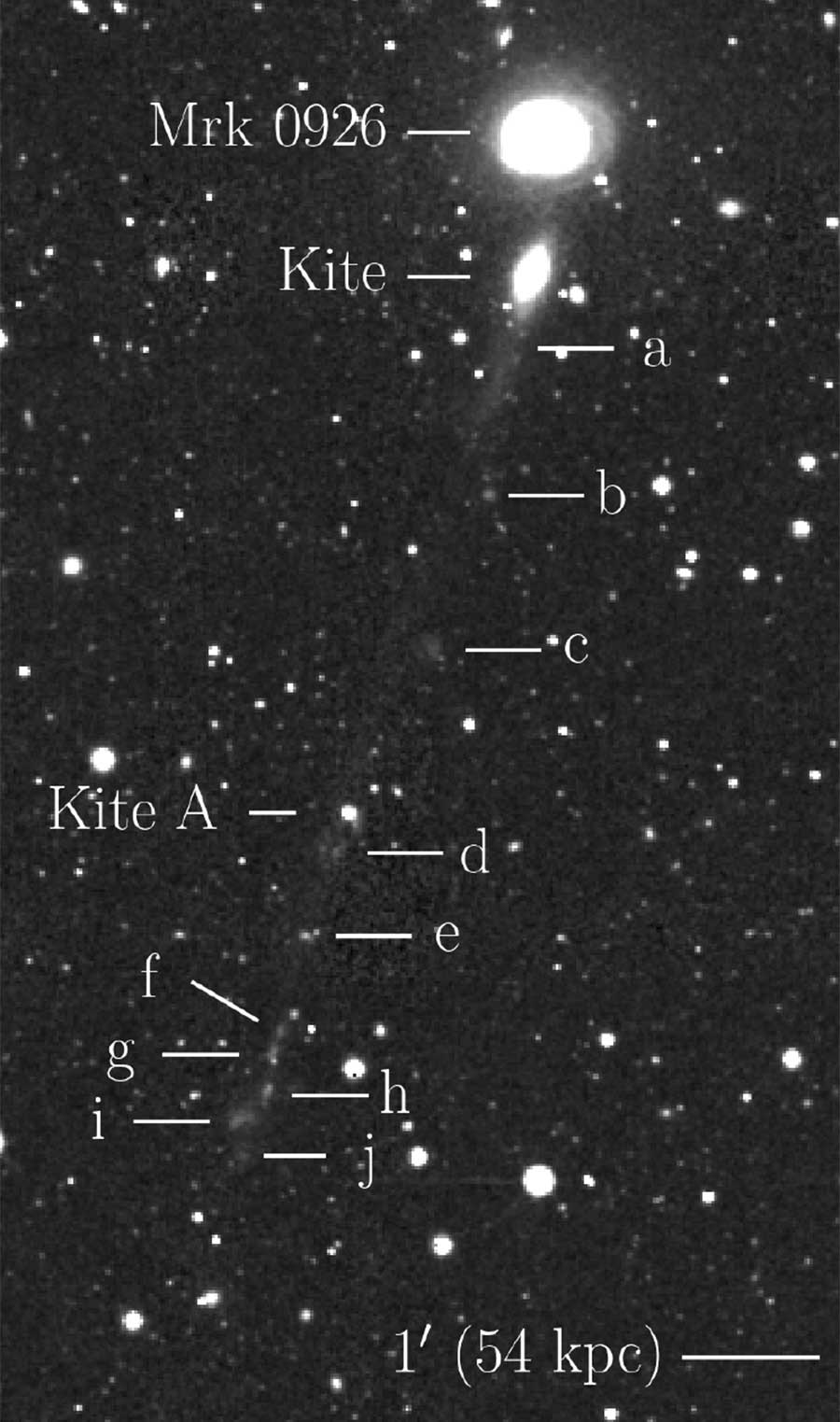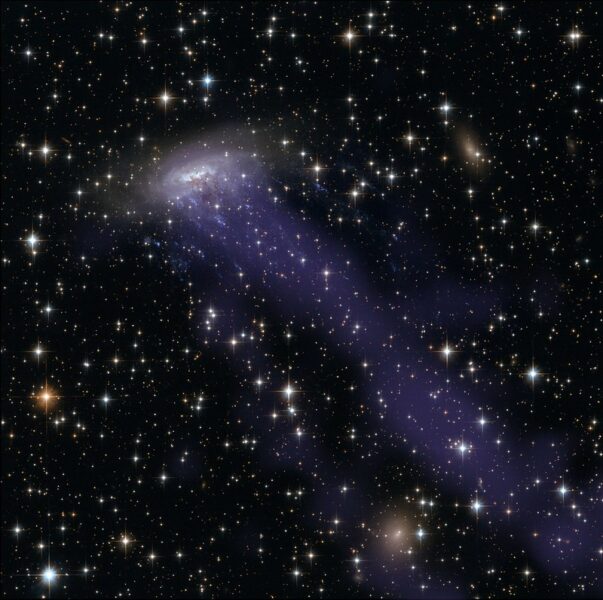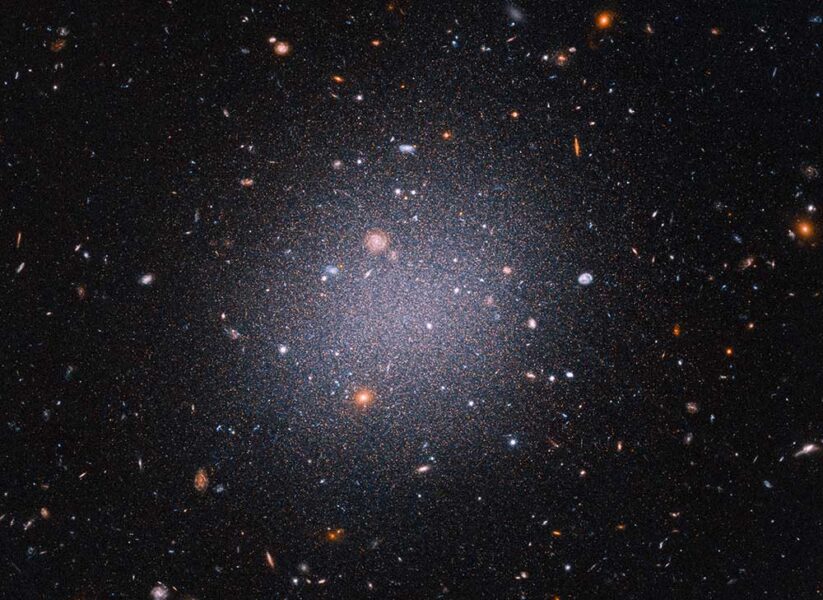From - Sky & Telescope,
By - Monica Young,
Edited by - Amal Udawatta,

Zaritsky et al. / Monthly Notices of the Royal Astronomical Society September 2023
Explaining a long, straight string of gas and star-forming knots presents a challenge.
A galaxy 600 million light-years away in the constellation Aquarius appears to be trailing gas in a string 1.2 million light-years long. It’s the longest galactic tail ever found in visible-light images, and it poses something of a conundrum for astronomers.
Dennis Zaritsky (Steward Observatory) didn’t start out looking for such a tail. He was conducting a survey for ultra-diffuse galaxies, faint galaxies with mysterious pasts that had largely escaped detection until recently. Now, advances in technology have made it possible to image some of the faintest objects in the universe. But in looking for these faint galaxies, Zaritsky found something completely different.
To confirm the detection of an ultra-diffuse galaxy in their survey, Zaritsky and other members of his team had to manually examine each candidate. “It often helps to zoom out in the image and get a better picture of the overall environment,” he explains. “In the case of the Kite, it was clear at once that we had an intriguing object.”
The Kite, so nicknamed because of its appearance, is an edge-on, disk-shaped galaxy that looks like it’s trailing gas in a long, narrow, and shockingly straight line across the sky. The line is one-sided, with no “partner” on the galaxy’s other side (as one might expect from black hole-powered jets).
Despite the wide expanse of space, there are no bends, curves, or wiggles in the Kite’s “string.” All along the string, though, there are knots of newborn stars. Zaritsky’s team took spectra to confirm that all of the knots and gas in the tail, including a small galaxy originally flagged as an ultra-diffuse candidate (nicknamed Kite A), all lie at the same distance from Earth, and so aren’t just chance alignments on the sky. The discovery is published in the September issue of the Monthly Notices for the Royal Astronomical Society.
Zaritsky’s team started with two possible explanations for the Kite’s string, and almost immediately nixed the most obvious: wind. If the Kite were gas-rich galaxy moving through a gas-rich medium, it would feel wind just like a bike rider feels wind on their face, even on a still day. The wind created by the galaxy’s motion would strip away its gas. Such “jellyfish” galaxies have been seen before, though their tails aren’t quite as long as the Kite’s. But the Kite itself doesn’t have much gas, and neither do its surroundings, so this explanation doesn’t work.

NASA / ESA / CXC
A FORTUITOUS FLING
The remaining option is simple gravity: If the Kite tussled with a satellite galaxy, it could conceivably have stripped away a tail of its gas. In fact, the satellite might have been the one we now see as Kite A.
But there are some drawbacks to this scenario, the main one being that it requires what the astronomers call a “fortuitous orientation.” Usually, when two galaxies interact, gravity pulls out so-called tidal tails on either side of the galaxies, and those tails follow the ellipse of the initial orbit. For us to see a straight line, we must be seeing a collision that happened perpendicular to the plane of the sky, aligned with the Kite’s nearly edge-on disk. (And if that’s the case, then the tail could be even longer than it appears!)
What’s more, given the ongoing star formation in the tail, the collision must have happened recently and at surprisingly high velocity. (The fact that the gas stream is so long and narrow supports the idea of recent formation — if it were old, then it ought to have more disturbances.) The team suggests that it was Kite A that hit the Kite with a velocity of 460 km/s or 1 million mph before escaping the system. It now lies more than 500,000 light-years away.
If this collision scenario pans out, then the Kite’s tail is interesting not just as a curiosity but for its wider implications. Over the past few years, astronomers have found a number of galaxies that appear to be mysteriously devoid of dark matter. Their origin has been debated, but a galactic collision could be one way to make them. The clumps along the gaseous tail are all expected to be dark matter–free, even the ones forming stars.

Pieter van Dokkum et al. / Nature 2022
There’s a lot of work left to do, Zaritsky says. One odd characteristic of some dark matter-free galaxies is unusually luminous star clumps known as globular clusters. The team has put in a proposal to observe the region with the Hubble Space Telescope to look for these around Kite A and the other clumps along the tail. They also have additional information about the gas distribution that still needs to be analyzed.
Mireia Montes (Institute of Astrophysics of the Canaries, Spain), who was not involved in the study, says a recent collision seems like a good explanation for what they’re seeing. “However,” she adds, “simulations would be required to assess if a scenario like the one proposed is actually possible.” Zaritsky agrees, though he notes such work is outside of his group’s expertise. “Eventually,” he says, “we need to do some numerical simulations of possible three-body events to see if we can reproduce this system.”
Comments
Post a Comment